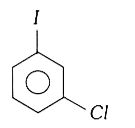The compound X in the reaction,





The correct Answer is:B
The ICl on reaction with anhy. AlCl3 produces I+ (electrophile), consequently, the final product is iodobenzene.

Topper's Solved these Questions
- HELOALKANES AND HALOARENESBOOK - ERRORLESSCHAPTER - HELOALKANES AND HALOARENESEXERCISE - Assertion & Reason
8 Videos
- HELOALKANES AND HALOARENESBOOK - ERRORLESSCHAPTER - HELOALKANES AND HALOARENESEXERCISE - NCERT BASED QUESTIONS (Different Halogen Derivatives of Hydrocarbons)
14 Videos
- GENERAL PRINCIPLES & PROCESSES OF ISOLATION OF ELEMENTSBOOK - ERRORLESSCHAPTER - GENERAL PRINCIPLES & PROCESSES OF ISOLATION OF ELEMENTSEXERCISE - ASSERTION & REASON
8 Videos
- ORGANIC COMPOUNDS CONTAINING NITROGENBOOK - ERRORLESSCHAPTER - ORGANIC COMPOUNDS CONTAINING NITROGENEXERCISE - Assertion and Reason
15 Videos
Similar Questions
Knowledge Check
Ca2B6O11+2Na2CO3→X+2CaCO3+2NaBO2 The compound X in the above reaction is
ANa2B4O7BHBO2CH3BO3DH2B4O7Sulphide ion reacts with [Fe(CN)5NO] to form a purple coloured compound (X). In this reaction oxidation state of iron .
Achanges from +2 to +3Bchanges from +3 to +2Cchanges from +2 to +4Ddoes not change.The compound X on reaction with HgSO4+H2SO4 gives
Y which one oxidation gives acetic acid. X isAC2H2BC2H4CC3H4DC4H6
An unknown inorganic compound (X) gave the following reactions:
(i) The compound (X) on heating gave a residue, oxygen and oxide of nitrogen.
An aqueous solution of compound (X) on addition to tap water gave a turbidity which did not dissolve in HO3+
(iii) The turbidity dissolved in NH4OH .
Identify the compound (X) and gives equation for the reaction (i),(ii) & (iii)
View SolutionAn unknown inorganic compound (X ) gave the following reactions.
(i) The compound (X ) on heating gas a residue, oxygen and oxide of nitrogen.
(ii) An aqueous solution of compound (X) on addition to tap water gas a turbidity which did not dissolve in HNO3.
(iii) The turbidity dissolved in NH4OH.
Identify the compound (X) and give equations for the reactions (i),(ii) & (iii).
View SolutionA reaction characteristic of vicinal diols is their oxidative cleavage on treatment with periodic acid (HIO4). The carbon-carbon bond of the vicinal diol uinit is broken and two carbonyl groups result. Periodic acid is reduced to iodic acid (HIO3)

Cyclic diols react to give dicarbonyl compounds. The reactions are faster when the hydroxyl gorups are cid than when they are trans but both stereoisomers are oxidised by periodic acid. Periodic acid cleavage of vicinal diols is often used for analytic purposes as an aid in structure determination. By identifying the carbonyl compounds produced, The constitution of the diol may be deduced.

The compound 'X' in above reaction is :
View Solution
Compound (x) in the above reaction is :
View SolutionThe compound X in the following reaction is……...

View Solution

